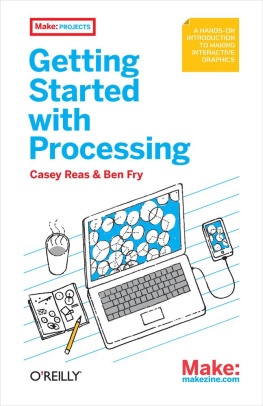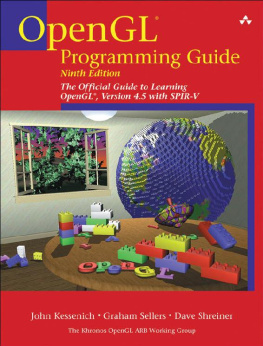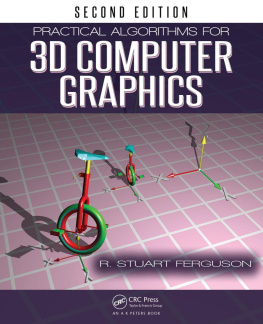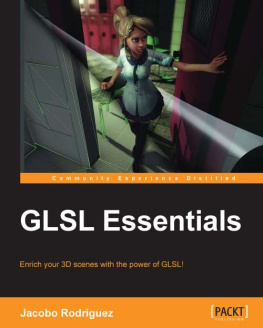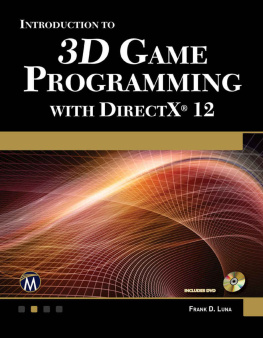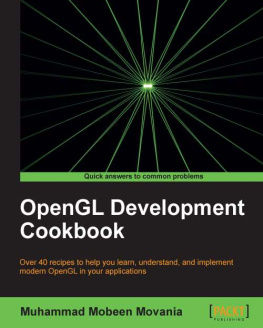COMPUTER GRAPHICS
PROGRAMMING IN OPENGL
WITH C++
LICENSE, DISCLAIMER OF LIABILITY, AND LIMITED WARRANTY
By purchasing or using this book and its companion files (the Work), you agree that this license grants permission to use the contents contained herein, including the companion files, but does not give you the right of ownership to any of the textual content in the book / files or ownership to any of the information or products contained in it. This license does not permit uploading of the Work onto the Internet or on a network (of any kind) without the written consent of the Publisher. Duplication or dissemination of any text, code, simulations, images, etc. contained herein is limited to and subject to licensing terms for the respective products, and permission must be obtained from the Publisher or the owner of the content, etc., in order to reproduce or network any portion of the textual material (in any media) that is contained in the Work.
MERCURY LEARNING AND INFORMATION (MLI or the Publisher) and anyone involved in the creation, writing, or production of the companion files, accompanying algorithms, code, or computer programs (the software), and any accompanying Web site or software of the Work, cannot and do not warrant the performance or results that might be obtained by using the contents of the Work. The author, developers, and the Publisher have used their best efforts to insure the accuracy and functionality of the textual material and/or programs contained in this package; we, however, make no warranty of any kind, express or implied, regarding the performance of these contents or programs. The Work is sold as is without warranty (except for defective materials used in manufacturing the book or due to faulty workmanship).
The sole remedy in the event of a claim of any kind is expressly limited to replacement of the book and/or companion files, and only at the discretion of the Publisher. The use of implied warranty and certain exclusions vary from state to state, and might not apply to the purchaser of this product.
The companion files are available for downloading by writing to the publisher at.
COMPUTER GRAPHICS
PROGRAMMING IN OPENGL
WITH C++
V. Scott Gordon, Ph.D.
California State University, Sacramento
John Clevenger, Ph.D.
California State University, Sacramento

MERCURY LEARNING AND INFORMATION
Dulles, Virginia
Boston, Massachusetts
New Delhi
Copyright 2019 by MERCURY LEARNING AND INFORMATION LLC. All rights reserved.
This publication, portions of it, or any accompanying software may not be reproduced in any way, stored in a retrieval system of any type, or transmitted by any means, media, electronic display or mechanical display, including, but not limited to, photocopy, recording, Internet postings, or scanning, without prior permission in writing from the publisher.
Publisher: David Pallai
MERCURY LEARNING AND INFORMATION
22841 Quicksilver Drive
Dulles, VA 20166
www.merclearning.com
(800) 232-0223
V. Scott Gordon & John Clevenger.
Computer Graphics Programming in OpenGL with C++
ISBN: 978-1-683922-21-6
The publisher recognizes and respects all marks used by companies, manufacturers, and developers as a means to distinguish their products. All brand names and product names mentioned in this book are trademarks or service marks of their respective companies. Any omission or misuse (of any kind) of service marks or trademarks, etc. is not an attempt to infringe on the property of others.
Library of Congress Control Number: 2018949985
181920321Printed on acid-free paper in the United States of America.
Our titles are available for adoption, license, or bulk purchase by institutions, corporations, etc. For additional information, please contact the Customer Service Dept. at 800-232-0223 (toll free). Digital versions of our titles are available at: .
The sole obligation of MERCURY LEARNING AND INFORMATION to the purchaser is to replace the book and/or disc, based on defective materials or faulty workmanship, but not based on the operation or functionality of the product.
Contents
Preface
This book is designed primarily as a textbook for a typical computer science undergraduate course in OpenGL 3D graphics programming. However, we have also endeavored to create a text that could be used to teach oneself, without an accompanying course. With both of those aims in mind, we have tried to explain things as clearly and simply as we can. All of the programming examples are stripped down and simplified as much as possible, but they are still complete so that the reader may run them all as presented.
One of the things that we hope is unique about this book is that we have strived to make it accessible to a beginnerthat is, someone new to 3D graphics programming. While there is by no means a lack of information available on the topicquite the contrarymany students are initially overwhelmed. This text is our attempt to write the book we wish we had had when we were starting out, with step-by-step explanations of the basics, progressing in an organized manner up through advanced topics. We considered titling the book shader programming made easy; however, we dont think that there really is any way of making shader programming easy. We hope that we have come close.
This book teaches OpenGL programming in C++. There are several advantages to learning graphics programming in C++:
OpenGLs native language is C, so a C++ program can make direct OpenGL function calls.
OpenGL applications written in C++ typically exhibit very high performance.
C++ offers modern programming constructs (classes, polymorphism, etc.) not available in C.
C++ is a popular language choice for using OpenGL, and a large number of instructional resources for OpenGL are available in C++.
It is worth mentioning that there do exist other language bindings for OpenGL. Popular alternatives exist for Java, C#, Python, and many others. This textbook focuses only on C++.
Another thing that makes this book unique is that it has a sister textbook: Computer Graphics Programming in OpenGL with Java. The two books are organized in lockstep, with the same chapter and section numbers and topics, figures, exercises, and theoretical descriptions. Wherever possible, the code is organized similarly. Of course, the use of C++ versus Java leads to considerable programming differences. Still, we believe that we have provided virtually identical learning paths, even allowing a student to choose either option within a single classroom.
An important point of clarification is that there exist both different versions of OpenGL (briefly discussed later) and different variants of OpenGL. For example, in addition to standard OpenGL (sometimes called desktop OpenGL), there exists a variant called OpenGL ES, which is tailored for development of embedded systems (hence the ES). Embedded systems include devices such as mobile phones, game consoles, automobiles, and industrial control systems. OpenGL ES is mostly a subset of standard OpenGL, eliminating a large number of operations that are typically not needed for embedded systems. OpenGL ES also adds some additional functionality, typically application-specific operations for particular target environments. This book focuses on standard OpenGL.
Yet another variant of OpenGL is called WebGL. Based on OpenGL ES, WebGL is designed to support the use of OpenGL in web browsers. WebGL allows an application to use JavaScript to invoke OpenGL ES operations, which makes it easy to embed OpenGL graphics into standard HTML (web) documents. Most modern web browsers support WebGL, including Apple Safari, Google Chrome, Microsoft Internet Explorer, Mozilla Firefox, and Opera. Since web programming is outside the scope of this book, we will not cover any WebGL specifics. Note however that because WebGL is based on OpenGL ES, which in turn is based on standard OpenGL, much of what
Next page


